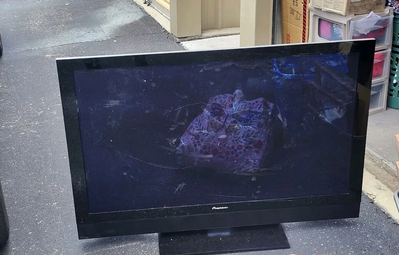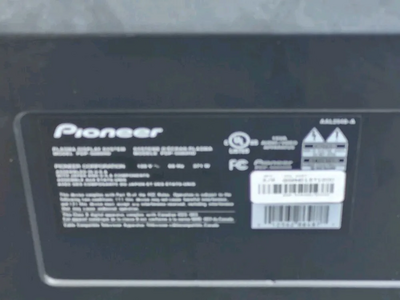
Pioneer PDP-6010FD
| Brand | Pioneer 2004 |
| Model | PDP-6010FD |
| Released Year | 2004 |
| Type | TV |
| Screen Size | 60 inches |
| Resolution | 1024 x 768 (XGA) |
| Refresh Rate | 60 Hz |
| Display Technology | Plasma |
| Status | Discontinued |
Quick view
Overview
The Pioneer PDP-6010FD is a 60-inch plasma television known for its pioneering plasma display technology aimed at delivering vibrant colors and deep blacks. It features a resolution of 1024 x 768 pixels (XGA), supporting progressive scan for enhanced picture clarity. The TV uses a passive matrix plasma panel aimed at improving color accuracy and viewing angles. Equipped with multiple HDMI and component inputs, it supports various video sources including HD content. It incorporates a digital comb filter and progressive scan circuitry for image quality improvements. The unit features a 24-bit video processing system to enhance color depth and reduce image noise.
Specifications
| MPN | PDP-6010FD |
| UPC | 0012562864907 |
| Model | PDP-6010FD |
| Display Technology | Plasma |
| Smart TV Features | Not Supported |
| Refresh Rate | 60 Hz |
| Features | Headphone Jack |
| Weight | Approx. 75 kg |
| Depth | 4.81in |
| Height | 34.71in |
| Width | 57.93in |
| Built-In Tuner | NTSC, QAM, ATSC |
| TV Type | Flat Panel |
| Front Input Connectors | USB Port |
| Room Type | Commercial Space, Living Room, Large Hall |
| Speaker Power | 2x8.5W |
| Energy Star | Non-Energy Star Compliant |
| On Mode Power | 532W |
| Audio Type | Virtual Surround |
| Subwoofer | With Subwoofer |
| Display Resolution | 1920x1080 Pixels |
| Adjustable Color Temperature | With Adjustable Color Temperature |
| 3D Technology | 3d Not Supported |
| Definition | HDTV |
| Number of Speakers | 2 |
| About the Brand | Pioneer is a Japanese multinational corporation established in 1938 by Nozomu Matsumoto. The company is worldwide famous for producing reliable, high quality products such as navigation systems, DVD players and recorders, DJ equipment and televisions. As Pioneer played a significant role in the development of plasma and OLED display technologies, it has contributed excellent models to the world of televisions in regards to performance and picture quality. The company offers a wide range of screen sizes, innovative designs and high-definition resolutions, all engineered for the ultimate entertainment experience beyond sight and sound. |
| Comb Filter | 3dyc / 3d Digital |
| Remote Control Type (Originally Supplied by Manufacturer) | Standard |
| Exterior Color | Black |
| Supported Resolutions | 1080p (HDTV), 1080i (HDTV), 720p (HDTV), 480p (Edtv), 480i (Sdtv) |
| OSD Languages | English, French, Spanish |
| Rear Output Connectors | Optical Digital, Audio (RCA) X 1, Subwoofer Output |
| Screen Size | 60 inches |
| Family Line | Kuro |
| Aspect Ratio | 4:3 |
| Sleep Mode Power | 20W |
| Maximum Resolution | 1080p |
| Rear Input Connectors | Audio (RCA) X 2, S-Video X 1, Composite X 3, RF X 2, Component X 2, Hdmi X 4 |
| Parental Control | V-Chip |
| Display Type | Plasma |
| Resolution | 1024 x 768 (XGA) |
| Inputs | HDMI x 3, Component Video, Composite Video, S-Video |
| Progressive Scan | Yes |
| Color Processing | 24-bit video processing |
| Audio Output | Stereo speakers 20W total |
| Power Consumption | Approx. 400 Watts |
| Dimensions (WxHxD) | Approx. 1410 x 1040 x 600 mm |
| Special Features | Digital comb filter, Picture-in-Picture |
| Manufacture Year | 2004 |
| Discontinued | Yes |
Images
Key Advantages
The PDP-6010FD offers a large 60-inch screen size, providing an immersive viewing experience. Its plasma technology delivers deeper blacks compared to early LCD models, improving contrast performance. The progressive scan feature enhances the sharpness and detail of high-definition sources. Multiple input options allow compatibility with various devices, making it versatile for home entertainment. The design includes a relatively thin profile for its generation, allowing for easier placement in living rooms. Pioneer’s image processing technology helps minimize motion blur and improve picture fidelity.
Limitations
Being an early plasma display, the PDP-6010FD is susceptible to image retention or burn-in under prolonged static image exposure. The native resolution of 1024 x 768 is lower compared to later HDTV standards, limiting full HD compatibility. Its power consumption is relatively high compared to modern flat-panel TVs. The set does not support advanced smart TV features, and connectivity options are limited to legacy inputs. The viewing angle, while better than early LCDs, may exhibit some color shift at extreme angles. The bulky form factor and weight make wall mounting and transportation more challenging.
FAQ
What is the screen size of the Pioneer PDP-6010FD?
The Pioneer PDP-6010FD features a 60-inch plasma display screen.
Does the PDP-6010FD support HD resolution?
It supports a resolution of 1024 x 768 pixels, which is XGA, providing decent image quality but lower than full HD standards.
What connectivity options are available on the PDP-6010FD?
The TV includes multiple HDMI inputs, component video inputs, and standard analog connections.
Is the Pioneer PDP-6010FD still in production?
No, the PDP-6010FD is a discontinued model.
Are there any known issues with this plasma TV?
Common issues include potential image retention and relatively high power consumption.
Can the PDP-6010FD display progressive scan video?
Yes, it supports progressive scan for improved picture clarity.
What type of panel technology does this TV use?
It uses plasma display technology with a passive matrix panel.
Disclaimer
The content on is provided for general informational purposes only. We do not guarantee the accuracy, completeness, or reliability of any information, specifications, or visuals presented on the site.
is not responsible for any content, images, or data uploaded or shared by users. Users are solely responsible for the content they submit.
We may include links to third-party websites for convenience. We do not endorse or take responsibility for the content or policies of any external sites.
Use of the site is at your own risk. Always verify critical information independently before making decisions based on content from this website.





